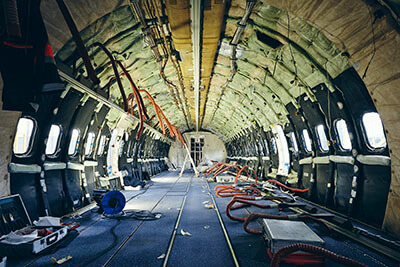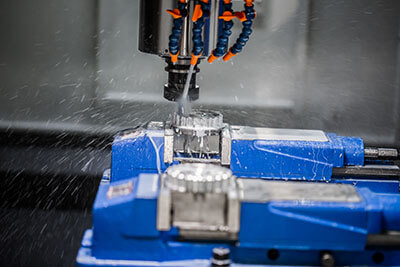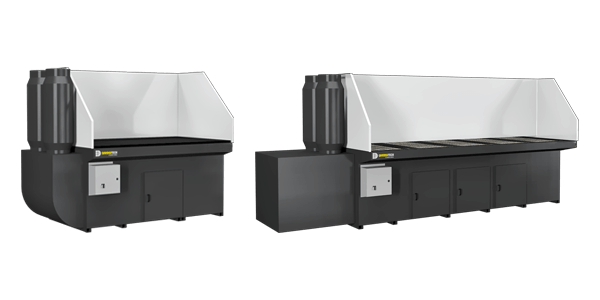Aerospace
Overview
The aerospace industry researches, develops and manufactures components and aircraft for flight within and beyond Earth’s atmosphere.  A high-technology industry, the aerospace sector supplies five major market segments: military aircraft, commercial airliners, missiles, space and general aviation.
A high-technology industry, the aerospace sector supplies five major market segments: military aircraft, commercial airliners, missiles, space and general aviation.
Rapidly growing and changing, the aerospace industry is considered to be one of the largest and most powerful in the United States today. To remain competitive, technological progress is essential for businesses in the aerospace sector. It’s for this reason that aerospace is a world leader in the advancement of science and technology.
Manufactured Equipment and Required Applications
Because aircraft vehicles require millions of individual parts as well as many support systems to operate and maintain, the industry’s product line is expansive. The aerospace sector produces aircraft, guided missiles, space vehicles, aircraft engines, satellites, propulsion units and their related parts as well as their prototypes.
The manufacturing of aerospace equipment and parts requires a number of processes that produce toxins which can have an adverse impact on worker health. Applications used in the aerospace industry include:
Welding
The welding of materials produces smoke, dust and fumes that contaminate indoor air and can negatively affect worker health. Most notably, the welding of stainless steel creates hexavalent chromium, a known carcinogen with numerous health risks including:
- Respiratory irritation
- Severe nasal and skin ulcerations and lesions
- Liver and kidney failure
- Birth defects
- Allergy symptoms (wheezing, shortness of breath)
- Nasal sores and perforation of the membrane separating the nostril
- Eye irritation and damage
- Perforated eardrums
- Pulmonary congestion and edema
- Upper abdominal pain
- Erosion and discoloration of the teeth
- Lung and nasal cancers
Welding smoke also contains other toxins including: nickel, arsenic, asbestos, manganese, silica, beryllium, cadmium, nitrogen oxides, phosgene, acrolein, fluorine compounds, carbon monoxide, cobalt, copper, lead, ozone, selenium, and zinc. Nickel has been classified as a carcinogen while studies have linked manganese to Parkinson-like symptoms. Exposure to levels of cadmium can be fatal.
Other illnesses associated with welding include:
- Nausea and/ or vomiting
- Headaches and dizziness
- Chest pain
- Respiratory damage
- Lead poisoning
- Nervous system damage
- Pulmonary edema (fluid in lungs)
- Metal fume fever
- Pneumonitis (inflammation of the lungs)
- Reproductive problems
- Emphysema
- Silicosis
- Siderosis
Capture-at-source remains the best option when it comes to controlling weld smoke, dust and fumes. Diversitech’s extractions arms, portable fume extractors and downdraft tables collect toxins before they have a chance to contaminate indoor shop air and remain the trusted choice of North America’s largest manufacturers.
Grinding and Deburring
Grinding and deburring creates dusts and particles that pollute indoor air if not captured at source. Depending on the type of application used, grinding and deburring produces airborne metal, composite, rubber or fiberglass dust that can be highly toxic when inhaled.
grinding and deburring produces airborne metal, composite, rubber or fiberglass dust that can be highly toxic when inhaled.
Most health conditions caused by grinding dusts concern the lungs. When inhaled on a regular basis, these dusts have been known to cause pneumoconiosis, also known as “dusty lung”. Over time, pneumoconiosis leads to a buildup of scar tissue in the lining of the lungs, contributing to serious, chronic issues.
But the lungs are not the only organs at risk from grinding dusts. Some of the particles produced by grinding can dissolve in the bloodstream, affecting the liver, kidneys and possibly the brain.
The containment of dusts from metals like aluminum, titanium and magnesium present a big challenge in the aerospace sector. Besides causing health problems in workers, many of these metallic dusts are also combustible. As one of the largest industries to use these metals, aerospace businesses need to make the safe capture of combustibles a priority. Even a small build-up of these metallic dusts can result in a catastrophic explosion that results in injury, loss of life and facility destruction.
Both the Occupational Safety and Health Administration (OSHA) and the National Fire Protection Association (NFPA) have recommended guidelines for the safe capture of combustibles. At Diversitech, we understand the unique challenges businesses in the aerospace sector face. Our line of wet dust collectors and wet downdraft tables help keep you OSHA and NFPA compliant.
Additive Manufacturing (3D Printing)
The aerospace industry continues to rely on additive manufacturing to produce complex R&D and production parts. Additive manufacturing can create combustible dusts with post processing 3D printing parts, causing risk of fire and explosion. These printers also release ultrafine particles (UFP) and volatile organic compounds (VOC) during their processes which produce toxic fumes and vapors.
UFP’s easily invade the human body and have direct impact on the lungs, causing conditions like asthma. They have also been associated with cardiovascular conditions and can become carriers of toxins in the bloodstream. VOCs on the other hand, have been linked to cancer and can also cause:
- Eye, nose and throat irritation
- Headaches
- Nausea / vomiting
- Dizziness
- Worsening of asthma symptoms
- Liver damage
- Kidney damage
- Central nervous system damage
Metal powders produced by additive manufacturing have been linked to eye and skin irritation, pulmonary fibrosis, pulmonary disease and gastrointestinal issues.
For the collection of plastic particulate from additive manufacturing, Diversitech offers a number of self-contained cartridge dust collectors. Our wet downdraft tables are an effective solution for the safe handling of metallic combustible dusts.
CNC Wet Machining
Businesses in the aerospace sector often use CNC machines in the manufacturing of aircraft parts. Generating airborne mist and smoke from coolant, the risks associated with these machines are two-fold. Not only does the oil mist produced pose a breathing hazard for workers, but it can also wreak havoc  on other machines and electronics in the shop.
on other machines and electronics in the shop.
Epidemiological studies have linked long-term exposure of CNC oil mist to an increased susceptibility of several types of cancer. Other health problems associated with these machines include:
- Contact Dermatitis / Photosensitive allergic dermatitis
- Bronchial asthma
- Lipoid pneumonia
- Rhinitis
- Bronchitis
- Lung fibrosis
- Lung cancer
- Benign and malignant tumors of the scrotum
Oil mist from CNC machines also pose a risk of accident in the workplace as too much accumulation on the shop floor creates slick conditions where workers can fall and get hurt.
For the safe capture of oil mists, Diversitech supplies oil mist collectors you can connect directly via ductwork to CNC machines.
Sanding & Finishing
Similar to grinding and deburring, sanding and finishing produces a number of dusts that are toxic when inhaled. The type of health risks depends on the type of material and the abrasive being used. Whether it is wood, metal or plastics, each material poses its own unique health problems.
Many of the metals used in aerospace manufacturing have been primed with chromate. Sanding metals with chromate primer exposes workers to the hexavalent chromium putting them at risk of developing cancer. Other health problems associated with the finishing of metals includes:
- Black lung
- Silicosis
- Tuberculosis
- Kidney disease
- Lung cancer
- Mild respiratory irritation
- Nausea and/or vomiting
- Headaches and dizziness
- Irritated eyes, nose and throat
- Chest pain
- Respiratory damage
- Difficulty breathing
- Excess fluid in the lungs
- Lead poisoning
- Nervous system damage
Carbon fiber as well as fiberglass and composite particles present yet more health risks for workers in the aerospace industry.
Made of strong carbon atoms, carbon fibers create fine dusts when sanded. If uncontrolled, these dusts can stick into skin and mucous membranes, causing irritation. Carbon fibers also have an epoxy coating that can lead to health problems with exposure. Conditions associated with sanding carbon fibers include:
- Lung damage
- Eye and upper respiratory tract irritation
- Dizziness
- Drowsiness
- Nausea and/ or vomiting
The dust and particles created from sanding fiberglass have the potential to penetrate the trachea and lungs and cause damage. They can also lead to asthma, allergies and even cancer. If not contained, fiberglass dust can wreak havoc on computers and other production equipment as well.
To avoid the buildup of toxic dust in the workplace, capture-at-source is the best option. Because most finishing work is done over table surfaces, a downdraft table is a popular solution. Diversitech offers a number downdraft tables, environmental booths and cartridge dust collectors for the safe and effective collection of finishing dusts. For the effective control of carbon fiber, fiberglass and composite particles, installing an air filtration system with a HEPA filter is required. For wide belt sanding applications commonly used in the aerospace industry, Diversitech offers wet dust collectors that can be attached directly to the machines.
Painting & Coating
Also used in the aerospace industry, industrial spray painting applications produce volatile organic compounds (VOCs), spray paint overspray and dusts that can harm worker health.
Containing metals like chromium, cadmium and lead as well as other chemicals like isocyanates, toluene, petroleum naphtha and epoxy resins, paint overspray is toxic to humans. Serious health conditions caused by VOCs include:
- Respiratory inflammation and/or disease
- Skin rashes and inflammation
- Allergic reactions
- Nerve and brain damage
- Nausea
- Organ failure
- Headache
- Vomiting
Long-term exposure to VOCs can lead to cancer as well as central nervous system, liver and kidney disorders.
Collecting VOC fumes at-source is the best method for protecting worker health and ensuring cleaner indoor air. Understanding the dangers of industrial overspray and VOC exposure, Diversitech offers a number of capture-at-source solutions. Our FRED Overspray Master, as well as our downdraft booths with spray painting kit safely collect VOC fumes and dust.
Thermal Spraying
Thermal spraying is a coating process that propels semi-molten or molten materials onto a surface using a spray torch or gun. The materials used to create the coating varies and can include metals, alloys, ceramics or plastics.
The aerospace industry relies substantially on thermal spraying to increase the life span of many engine components. Hundreds of key parts in an aircraft engine require thermal spray coatings to operate efficiently.
Because the process creates metal fumes, the health problems associated with thermal spraying are similar to those of welding. Breathing in metal fumes exposes workers to a number of toxic metals like nickel and chromium. Thermal spraying stainless steel creates hexavalent chromium putting workers at risk for developing cancer. Other health concerns due to metal fume exposure include:
- Respiratory, eurological, and fertility problems
- Metal fume fever
- Parkinsonian Syndrome
Businesses also need to take into account the fire and explosion hazard these fine metallic dusts present. Safely capturing these combustible dusts is necessary to prevent a catastrophic event that could lead to worker injury, loss of life or property destruction.
To control metal fumes from thermal spraying, Diversitech offers a number of extractions arms and portable fume extractors. Our wet dust collectors safely capture combustible metal dusts, preventing the risk of fire and explosion.
